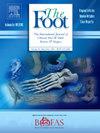Opposing flanks vs parallel flanks – The influence of screw design on compression and pull-out strength
Q2 Health Professions
引用次数: 0
Abstract
Background
Screws generate and maintain compression against distracting forces when performing osteotomy or fusion surgery. Headless screws have been recently designed with opposing flank angles (OFA) between the proximal and shaft threads and are purported to achieve better compression. The aim of this study was to compare OFA designs against traditional parallel flank angle (PFA) headless screws, and headed screws, to determine differences in compression and pull-out strength (POS).
Methods
This was a biomechanical, in-vitro sawbone study comparing four screw designs: two opposing flank headless designs (Screw AO, Screw BO), one parallel flank headless design (Screw CP) and one headed design (Screw DH). All screws were 4.0 mm diameter x 50 mm length, partially threaded, cannulated screws typically used in foot and ankle surgery (five screws tested for each design). Screw BO had a shorter and narrower proximal threaded portion than Screws AO and CP. A custom apparatus was designed for measuring compression and POS. An osteotomy was created in sawbone blocks of 0.32 g/cm 3 density which simulated cancellous bone. The divided segments were apposed with four strain-gauged load cells in between. Screws were inserted per manufacture recommendations, perpendicular to the osteotomy and maximum compression was measured. To measure POS, block segments were distracted in increasing increments until the construct failed.
Results
There was a significant difference in compression between all screws: Screw AO, 311.0 ± 4.2 N; Screw CP, 201.4 ± 28.6 N; Screw BO, 168.6 ± 15.9 N; Screw DH, 119.8 ± 13.2 N (p < 0.001). There was no significant difference in POS between Screw AO (466.0 ± 29.0 N) and Screw Cp (399.0 ± 46.0 N, p = 0.089), but the other screws had significantly lower POS: Screw BO, 310.0 ± 22.0 N; Screw DH, 183.0 ± 12.9 N (p < 0.001).
Conclusion
One of the OFA designs exhibited the highest compression and POS in this sawbone model. However, the variable results between designs suggests other screw design features may have a greater influence than the opposing of flank angles.
相对侧翼与平行侧翼——螺杆设计对压缩和拉出强度的影响
背景:在进行截骨术或融合手术时,螺钉产生并维持对分散力的压迫。最近设计的无头螺钉在近端螺纹和轴螺纹之间具有相对的侧面角(OFA),据称可以实现更好的压缩。本研究的目的是比较OFA设计与传统的平行侧角螺钉(PFA)无头螺钉和有头螺钉,以确定压缩和拉出强度(POS)的差异。方法采用生物力学、体外锯骨研究方法,比较了4种螺钉设计:2种相对的侧腹无头设计(螺钉AO、螺钉BO)、1种平行侧腹无头设计(螺钉CP)和1种头部设计(螺钉DH)。所有螺钉均为4.0 mm直径x 50 mm长度,部分螺纹空心螺钉,通常用于足部和踝关节手术(每种设计测试5颗螺钉)。BO螺钉比AO螺钉和CP螺钉的近端螺纹部分更短、更窄。设计了一种定制的仪器来测量压缩和POS。在0.32 g/ cm3密度的锯骨块中创建截骨,模拟松质骨。分开的节段之间放置四个应变测压元件。按照推荐的制作方法插入螺钉,垂直于截骨,测量最大压缩。为了测量POS,块段以递增的增量分散注意力,直到构造失败。结果各螺钉间的受压程度差异有统计学意义:螺钉AO为311.0 ± 4.2 N;螺钉CP, 201.4 ± 28.6 N;螺钉BO, 168.6 ± 15.9 N;螺钉DH, 119.8 ± 13.2 N (p <; 0.001)。之间没有显著差异在POS螺钉AO(466.0 ±29.0 N)和螺旋Cp( 399.0±46.0 N, p = 0.089),但是其他螺丝有明显降低POS:螺旋波, 310.0±22.0 N;螺钉DH, 183.0 ± 12.9 N (p <; 0.001)。结论在锯骨模型中,其中一种OFA设计表现出最高的压缩和POS。然而,不同设计之间的不同结果表明,其他螺钉设计特征可能比侧面角的相反方向有更大的影响。
本文章由计算机程序翻译,如有差异,请以英文原文为准。
求助全文
约1分钟内获得全文
求助全文
来源期刊

Foot
Health Professions-Podiatry
CiteScore
2.00
自引率
0.00%
发文量
37
期刊介绍:
The Foot is an international peer-reviewed journal covering all aspects of scientific approaches and medical and surgical treatment of the foot. The Foot aims to provide a multidisciplinary platform for all specialties involved in treating disorders of the foot. At present it is the only journal which provides this inter-disciplinary opportunity. Primary research papers cover a wide range of disorders of the foot and their treatment, including diabetes, vascular disease, neurological, dermatological and infectious conditions, sports injuries, biomechanics, bioengineering, orthoses and prostheses.
 求助内容:
求助内容: 应助结果提醒方式:
应助结果提醒方式:


